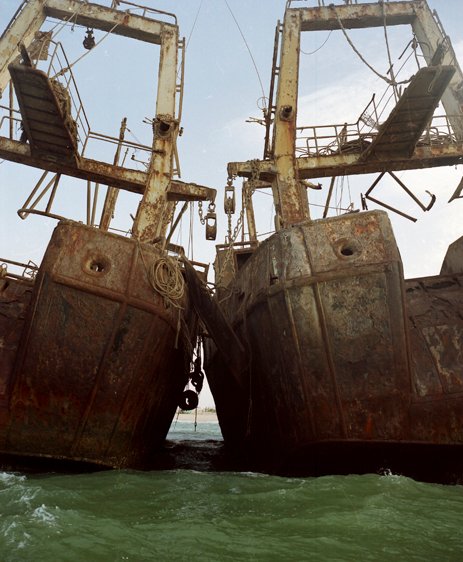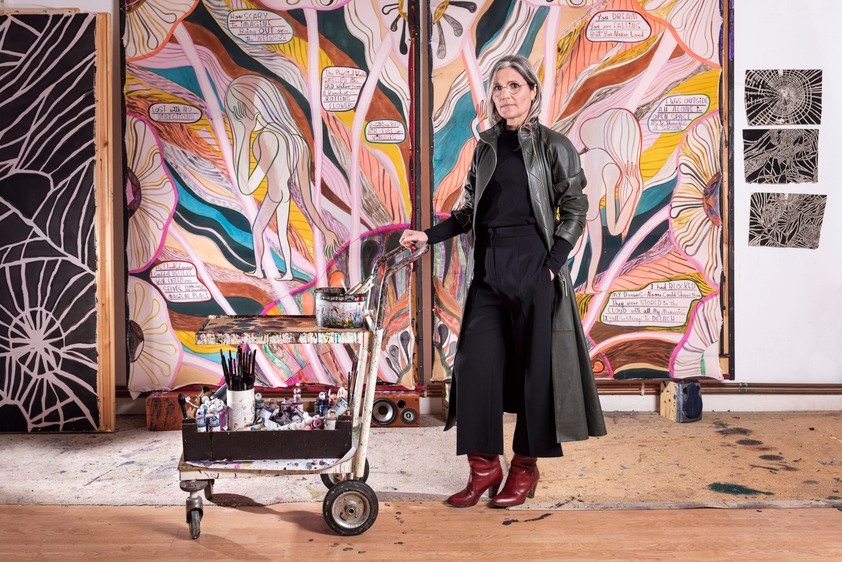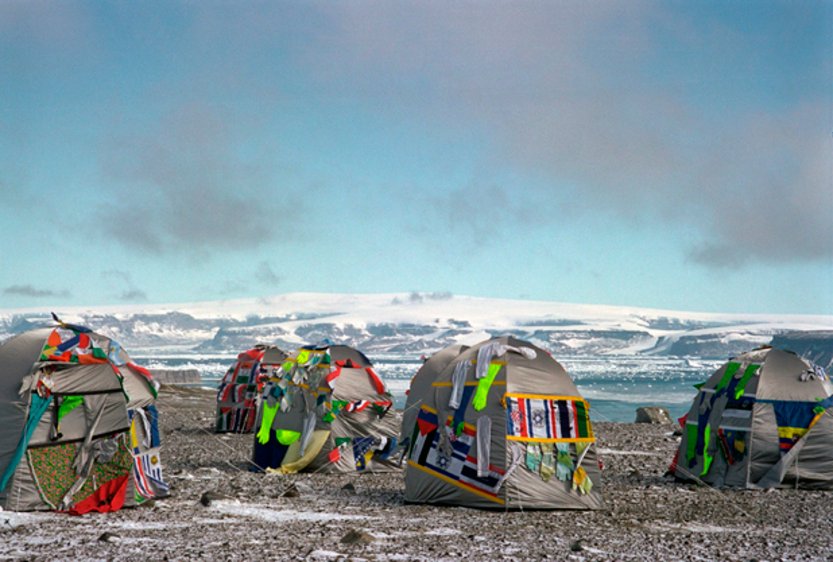United Kingdom –
I’m part of a small group of uninvited guests on an abandoned ship off the coast of Mauritania. Unsteady on my feet and pushed for time, I’m sizing up a dead fish that’s been blanched into a paper cut-out of its former self by weeks of punishing West African sunshine. The stench here is horrendous. Nearby I spot a fragment of an official-looking document written in Chinese. As I work to compose some frames of the array of debris on deck (mostly remnants of this now-ghoulish vehicle’s functional past) I am summoned away. We’re being called back to the smaller vessel that brought us here to satisfy our irresponsible curiosity. Lost in the demands of the task at hand, and careful not to waste my last eight frames of a 120 roll of film, it’s not until much later that I notice the pain caused by an embarrassing scarlet sunburn.
But sunburn is a minor inconvenience compared to those suffered by the local men who perform life-risking acrobatics to reach and break off huge, half-submerged chunks of metal with little more than a hacksaw and a hammer. Transported by tiny boats pulled to shore by ropes across dangerous waves, these scraps will fetch a few meagre dollars from a dealer. Some of these scrap merchants live on the very ships they are slowly dismantling. For decades, local government officials have been systematically bribed into welcoming the boats that are dumped here, then left to rot and fall apart in this nautical graveyard. It’s an arrangement which is considerably cheaper for the owners of the vessels than paying for safe and proper disposal.
 Zineb Sedira – The Death of a Journey – Mauritania – 2008
Zineb Sedira – The Death of a Journey – Mauritania – 2008
It’s 2009 and I’m here with the French-Algerian artist Zineb Sedira, a good friend at this point after several of these strange jaunts together. The material gathered on this trip will inspire a body of work that includes her Tate Britain video installation ‘Floating Coffins’, and several other solo shows, of which my photographs will form one part. One of the shots from this series, depicting two dilapidated boats leaning in to one another as though for support, or to conspire, will be called ‘The Lovers’.
As a photographer and artist specialised in collaborations, I’ve taken on a métier which, as well as requiring many unglamorous hours of desk-bound work, has given me the chance to work in extreme places such as Antarctica – where I worked with the artists Lucy and Jorge Orta – and the Sahara in Niger, where I joined a small team led by artist Marine Hugonnier and photographed the effects of a total solar eclipse on the landscape with a 5×4 large format camera. A nine-day journey for a nine-minute event. And then there was a sand storm. On the way back we somehow survived a bus crash which, tragically, proved fatal for some of the other passengers. These, and other ‘secondary’ events are forever attached in my consciousness to particular projects. On a film set in Ghana – shooting a series of photographs for an exhibition to accompany a film being made by the artist Doug Fishbone – witnessing a ‘ju-ju’ circle of fire raging out of control, is one of the occasions that stuck.
 Lucy & Jorge Orta – Antarctica – 2008
Lucy & Jorge Orta – Antarctica – 2008
In light of the above ‘dangers of the job’, an often-voiced criticism is that these kinds of art projects are pointless and risky adventures. There might be an element of truth in that, but I value them not so much for the notion of thrill-seeking, as the rewards reaped by the process of intense collaboration: the meticulous preparation, the trial and error, the tinkering and editing, all done to yield something that will hopefully make the viewer stop and reflect.
I’ve never been much of a documentary photography fiend. Although clearly significant, I can’t recount an occasion on which I felt much, if any, emotion looking at photographs by Henri Cartier-Bresson or Sebastião Salgado. My professional role models were always artists using photography in their practice; people such as Ed Rusha, John Baldessari, and later Jeff Wall and Thomas Ruff. Although not photographers in the strictest sense, I admired them because they knew why they were using the medium; simply because it seemed the most suitable tool to express a particular idea. If this was been paint and canvas, they would have gone for that. Therefore, from the start, my work as a photographer was entirely rooted in contemporary art, and collaborations with artists came naturally. These are complemented by my editorial photography for arts publications, portraits, and all manner of assignments for galleries and museums. I decided ages ago not to get too hung up about how to label those different strands of my practice. I am often asked about my ‘own’ work. Although I instigate many projects myself, and have more recently invited artists to develop ideas with me, I consider these varying activities to comprise more or less equal parts of my output. That’s not to say that I haven’t found myself in complex situations in which it was difficult not to muddy the creative boundaries and which made the task of determining ownership onerous. These days negotiations, if needed, have become more straightforward. Creative collaborations with contemporary artists are a calling card of sorts, and these too are my ‘own’ work and passion. It’s a distinction that can be slippery to pin down and explain, but one that always seems to matter more to the people who are the furthest removed from the creative work.
 Doug Fishbone – Elmina – 2010
Doug Fishbone – Elmina – 2010
Over the years this collaborative practice has taken all kinds of guises – from shooting the mesmeric Tilda Swinton as part of Hussein Chalayan’s film ‘Absent Presence’, for the 2005 Venice Biennial; to photographing the exploits of a tame fox that Francis Alÿs had let loose in London’s National Portrait Gallery as part of a 2007 Artangel commission. I’ve had the pleasure of creating a ‘mirror work’ for Michelangelo Pistoletto, and some rather psychedelic photographs to complement Daria Martin’s filmic work on synaesthesia. I have fond memories of working with Steve McQueen on his film ‘Gravesend’, and recently worked with Nordic artist duo Elmgreen & Dragset on their current V&A museum commission ‘Tomorrow’, which cleverly transforms several gallery rooms into an apartment belonging to a fictional, elderly and disillusioned architect. For the V&A magazine, I was asked to shoot the cover, on which the fictional architect (played here by a sometime film extra and real-life retired architect), was seen reading an edition of the same mag, but with an alternative cover based on another show at the museum. My other collaborations have included photographic work for and with the artists Jeremy Deller, Alice Channer, Jamie Shovlin, Idris Khan, Ryan Gander, Omer Fast, Grayson Perry, and Karen Russo. The functions of any photographs thus produced vary enormously, from promotion and documentation; to residual representations of performances; and photographs which become the final art works.
Frequently, I find that my favourite parts of the working day are moments that were unexpected. When I shot a portrait of the great conceptual innovator Gustav Metzger, for example, he had a rather intimate favour to ask: could I cut his hair? At 86, the artist found it hard to trim his hair and beard, and so for that one shoot I became stylist as well as photographer, which was of course my pleasure. Afterwards, it was fun thinking – admittedly at a stretch – that I had inadvertently enacted one of Metzger’s life-long preoccupations: destruction.
 Marine Hugonnier – Niger -2004
Marine Hugonnier – Niger -2004
Recently, during a four week residency in Siena, at an arts institution with links to an educational centre for the deaf, I completed the groundwork for a photographic process to capture sign language with a stills camera and strobes, in an attempt to investigate the parameters and difficulties of conveying metaphoric meaning visually. The work positions signing and photography as comparative languages. Again, this undertaking would be impossible without collaborations – I worked with deaf poets – which are at the centre of my photographic practice.
Another major, yet more ‘personal’ project, is the ‘One Photograph’ series, of texts published online on Various Small Fires and in a forthcoming book (planned for autumn 2014). I commission and edit essays in which I invite artists and writers to discuss the roles and functions of photographic images, starting from their personal engagement with a single chosen photograph. Writers so far have included, among others, David Campany, Geoff Dyer, Tom Morton, Adam Broomberg & Oliver Chanarin and Nathaniel Mellors.
 Oliver Chanarin and Adam Broomberg – 2011.jpg
Oliver Chanarin and Adam Broomberg – 2011.jpg
What I will remember most about my trip to Niger is probably just a simple moment of serendipity. Sitting on a dune, I was absent-mindedly sifting through grains of sand when I felt the surprise of a small, hard fragment between my fingertips. This was, it turned out, a pre-historic arrowhead. In its own way, as intriguing and expertly crafted as anything I’ve seen in a gallery.
Some things are definitely worth a bit of sunburn.
Thierry Bal is a Belgian photographer and artist based in London, specialised in collaborative projects with artists and arts publications worldwide. He is the editor of Various Small Fires, which contains a series of commissioned essays on the roles and functions of single photographic images. A book based on this series will be published in 2014.
















